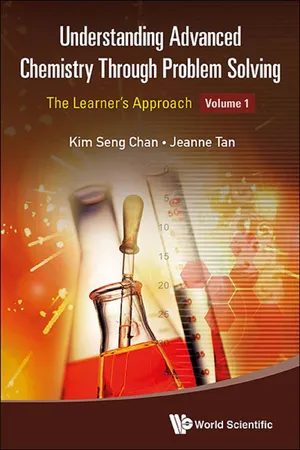
Understanding Advanced Chemistry Through Problem Solving
The Learner's ApproachVolume 1: Physical Chemistry and Inorganic Chemistry
- 340 pages
- English
- ePUB (mobile friendly)
- Available on iOS & Android
Understanding Advanced Chemistry Through Problem Solving
The Learner's ApproachVolume 1: Physical Chemistry and Inorganic Chemistry
About This Book
Written for students taking either the University of Cambridge Advanced Level examinations or the International Baccalaureate examinations, this guidebook covers essential topics and concepts under both stipulated chemistry syllabi. The book is written in such a way as to guide the reader through the understanding and applications of essential chemical concepts using the problem solving approach. The authors have also retained the popular discourse feature from their previous two books — Understanding Advanced Physical Inorganic Chemistry and Understanding Advanced Organic and Analytical Chemistry — to help the learners better understand and see for themselves, how the concepts should be applied during solving problems. Based on the Socratic Method, questions are implanted throughout the book to help facilitate the reader's development in forming logical conclusions of concepts and the way they are being applied to explain the problems. In addition, the authors have also included important summaries and concept maps to help the learners to recall, remember, reinforce and apply the fundamental chemical concepts in a simple way.
Topics are explored through an explanatory and inquiry-based approach. They are interrelated and easy to understand, with succinct explanations/examples being included, especially on areas that students frequently find difficult. Topics address the whys and hows behind key concepts to be mastered, so that the concepts are made understandable and intuitive for students. The focus is on conceptual learning so as to equip students with knowledge for critical learning and problem solving.
Existing A-level or IB guidebooks generally introduce concepts in a matter-of-fact manner. This book adds a unique pedagogical edge which few can rival. Through their many years of teaching experiences, the authors have acquired a sound awareness of common students' misconceptions which are relayed through the questions and thus help to reinforce concepts learnt. This book is essential and useful to help the students to be adequately prepared for their high stake examinations.
Request Inspection Copy
Contents:
- Part I: Physical Chemistry:
- Atomic Structure and the Periodic Table
- Chemical Bonding
- Ideal Gas and Gas Laws
- Chemical Thermodynamics
- Reaction Kinetics
- Chemical Equilibria
- Ionic Equilibria
- Redox Chemistry and Electrochemical Cells
- Part II: Inorganic Chemistry:
- The Periodic Table: Chemical Periodicity
- Chemistry of Groups 2 and 7
- Introduction to Transition Metals and Their Chemistry
Readership: JC students and teaching professionals in Chemistry.
Key Features:
- The book provides fundamental important scaffolding to aid students in creating their own understanding of the chemical concepts
- The book encourages critical thinking and meaningful applications, using the basic concepts learnt
- The book guides the students to integrate the various concepts they have learnt into a coherent and meaningful conceptual network
Frequently asked questions
Information
PART I
PHYSICAL CHEMISTRY
CHAPTER 1
ATOMIC STRUCTURE AND THE PERIODIC TABLE
| 1. | Naturally occurring boron consists of two isotopes, 10B and 11B, having abundances of 19.7% and 80.3%, respectively. | |
| (a) | Explain the terms isotope and relative isotopic mass. | |
Explanation for isotope:
Explanation for relative isotopic mass:
| Q | Why is 12C used as the reference standard? |
| (b) | Calculate the relative atomic mass of naturally occurring boron. |
Explanation:
Table of contents
- Cover Page
- Title Page
- Copyright Page
- Contents
- Preface
- Acknowledgements
- Part I Physical Chemistry
- Part II Inorganic Chemistry
- Index